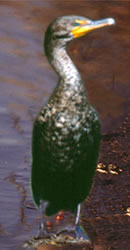
Dimdima
Online Children's Magazine from India

Dimdima
Online Children's Magazine from India
By Rani Iyer

Cormorants love fish. But what is cormorant fishing? You might wonder. It is a traditional Japanese river fishing method in which trained cormorants are used to catch fresh water fishes. The method has been practised for nearly 1300 years. The ‘Ukai’ (summer) is the traditional cormorant fishing season that falls from May through October. Ukai fishing team has three members. ‘Usho,’ the leader, guide, and handler of the cormorants has ‘Nakanori’ (middle rider) and the ‘Tomonori’ (companion rider) who picks up the fish and paddles the boat.
Special small flat-bottomed boats called ‘Ubune,’ are designed to be able to navigate the shallow waters of the rivers where the fish are easier to catch. Each boat is usually about 13 meters in length.
The boats are paddled out onto the river after dark. The fishermen attract the fish with bright burning fires in metal baskets suspended from the front of their boat. The cormorant birds sent out into the water to catch the fish is on a leash. The leash is attached to a small metal ring that is around the base of the cormorant's neck. The Usho’s skill prevents the lashes from becoming entangled as birds dive repeatedly for their catch.
Every time a cormorant brings a fish, the Usho pulls them back into the boat and disgorges the fish. The metal ring around the base of the cormorants neck is just large enough to let small fish through, but too small to let a bird swallow any fish of the size that fishermen need. The life span of a wild cormorant is approximately 4 years, but the Ukai cormorants live up to 20 years. The Usho keep them well fed and treat them like family.
Traditionally there were only male Ushos, now; female Ushos are seen. The Imperial household protects the tradition, and positions inherited are passed on within a family. Apprentices train for four seasons. The fishermen wear the traditional clothing worn by their ancestors - a straw skirt that repels water, a dark cotton kimono, and a black linen cloth that is wrapped around the head to fend off sparks. Ukai is no longer wide spread in Japan, as it is not economically viable in the modern days. Cormorant fishing is also seen in China. It is said that one good cormorant can feed a whole family.
Last updated on :4/13/2004
EXPLORE MORE...
COMMENT ON THIS ARTICLE
Wants to share something related to this article? Please use the form below.
Dimdima is the Sanskrit word for ‘drumbeat’. In olden days, victory in battle was heralded by the beat of drums or any important news to be conveyed to the people used to be accompanied with drumbeats.
Bharatiya Vidya Bhavan
K. M Munshi Marg,
Chowpatty, Mumbai - 400 007
email : editor@dimdima.com
Bharatiya Vidya Bhavan
505, Sane Guruji Marg,
Tardeo, Mumbai - 400 034
email : promo@dimdima.com
Dimdima.com, the Children's Website of Bharatiya Vidya Bhavan launched in 2000 and came out with a Printed version of Dimdima Magazine in 2004. At present the Printed Version have more than 35,000 subscribers from India and Abroad.